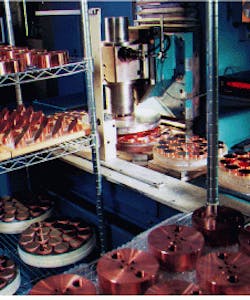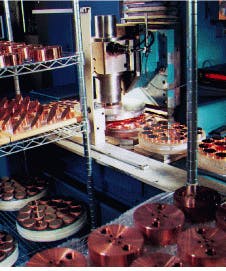Industrial optics manufacturers challenged on performance and cost
Industrial optics manufacturers challenged on performance and cost
Dean T. Hodges
Rather quietly over the last decade machine tools based on carbon dioxide (CO2) lasers have become a ubiquitous part of modern materials processing. While used primarily for metal working--cutting, welding, and transformation hardening, for example--such systems also address a diverse and growing applications spectrum for other materials. Processing systems can be configured using CO2 laser platforms and power levels ranging from sealed-off devices capable of delivering CW output power from 10 to 200 W to dc- and rf-excited flow models with output powers from 1 to 6 kW. Higher-power CO2 lasers (10 to 20 kW) are also available in limited production quantities, and their popularity will surely increase.
Advanced controls that enable programming of laser parameters and beam-delivery motions are making these modern manufacturing tools increasingly more useful and easy to operate, while system reliability and flexibility are the equal of other more-traditional metal-working equipment. Underlying this sophisticated systems technology is a critical component technology--namely the infrared optics that form the laser cavity and subsequently effectively deliver the energy to the workpiece. The multikilowatt power densities involved place severe requirements on all the optical components, and very low energy absorption is essential for these elements to maintain optimum performance over extended lifetimes.
Innovation needed
High performance notwithstanding, however, today`s CO2 laser optics industry is maturing, and many of the optical components are now commodity items. At the same time, laser-systems developers and machine-tool builders are always looking to increase output powers in order to broaden the range of applications and to increase production throughput. This leading-edge segment presents a continuous technical and business challenge to optics manufacturers. Innovation is essential for continuing success, but the commodity nature of the established business provides little margin for the reinvestment that`s needed in technology development.
CO2 laser optics are fabricated from a variety of materials, the choice depending on whether the optics are reflective or transmissive. Commonly used reflective materials include copper, silicon, and germanium--each with a complicated metal and/or dielectric thin-film stack to provide reflectivity as high as 99.9% (see photo). Transmissive elements are usually dielectric-coated zinc selenide. Typical absorption for these elements is less than 0.1% for internal cavity optics and less than 0.2% for lenses.
Like other machine tools, the laser-based systems must run continuously two or three shifts per day and up to seven days weekly. The cleanliness of modern laser structures and the pressurized beam-delivery systems have greatly reduced optics maintenance and replacement requirements--often to an annual timescale. Reliability, including optics, is no longer an impediment to application growth.
Large nonmilitary market
For nonmilitary applications, the CO2 laser optics industry produces around 250,000 optical components per year; the total worldwide revenue value is approximately $50 million. Although the industrial-CO2 laser business was "invented" in the USA by companies such as Photon Sources--now part of Lumonics (Ontario, Canada)--and Coherent (Santa Clara, CA), much of that market is now dominated by non-US firms. Two US companies, however, retain a significant presence in the worldwide optics market. II-VI (Saxonburg, PA) and Laser Power Corp. (San Diego, CA) together account for a combined market share in excess of 60%. Other significant players include Coherent, Sumitomo (Osaka, Japan), Rocky Mountain Instruments (Longmont, CO), and V&S Scientific (Potters Bar, UK).
Since early 1994 the machine-tool market has emerged from recession with strong laser-based tool sales in 1994 and the first half of 1995.* While system sales are projected to exceed 20% revenue growth, optics sales revenues will lag due to downward pricing pressure that has pushed average prices down by 5% in each of the last four years. The impact of the recent weakening of the dollar will certainly be felt in the market because of the strong US demand for machine-tool products built in Europe and Japan.
More for less the goal
Near-term trends for CO2 laser material processing are clear. The large-machine builders are moving from 2-kW laser platforms to 3.5 kW and will ultimately go to 6 kW and beyond. There is also vigorous activity in the 50- to 200-W output levels for a variety of "desk top" manufacturing applications (see Laser Focus World, June 1995, p. 49).
The trends for CO2 optics suppliers are equally clear--more for less. The producers` challenge is to provide increasingly higher quality and performance but at continuously lower prices. This is the ultimate innovation challenge. As CO2-laser-based materials processing applications become ever more widespread, new and innovative optics are needed to improve performance or to perform new functions. There is, for example, an increasing use of aspheric focusing lenses to focus a CO2 laser to a diffraction-limited spot size. This is accomplished by diamond-turning the appropriate aspheric curve on the lens in order to eliminate spherical aberration arising from the steeply curved spherical radius of a meniscus lens. Other novel applications employ axicons and faceted optics.
The quest for even more output power with still-higher beam quality will continue to drive optical component suppliers with the never-ending challenge of enhanced performance and lower costs. n
Copper optics "polished" by diamond turning are used as laser- cavity optics and beam-delivery optics for industrial CO2 lasers.

